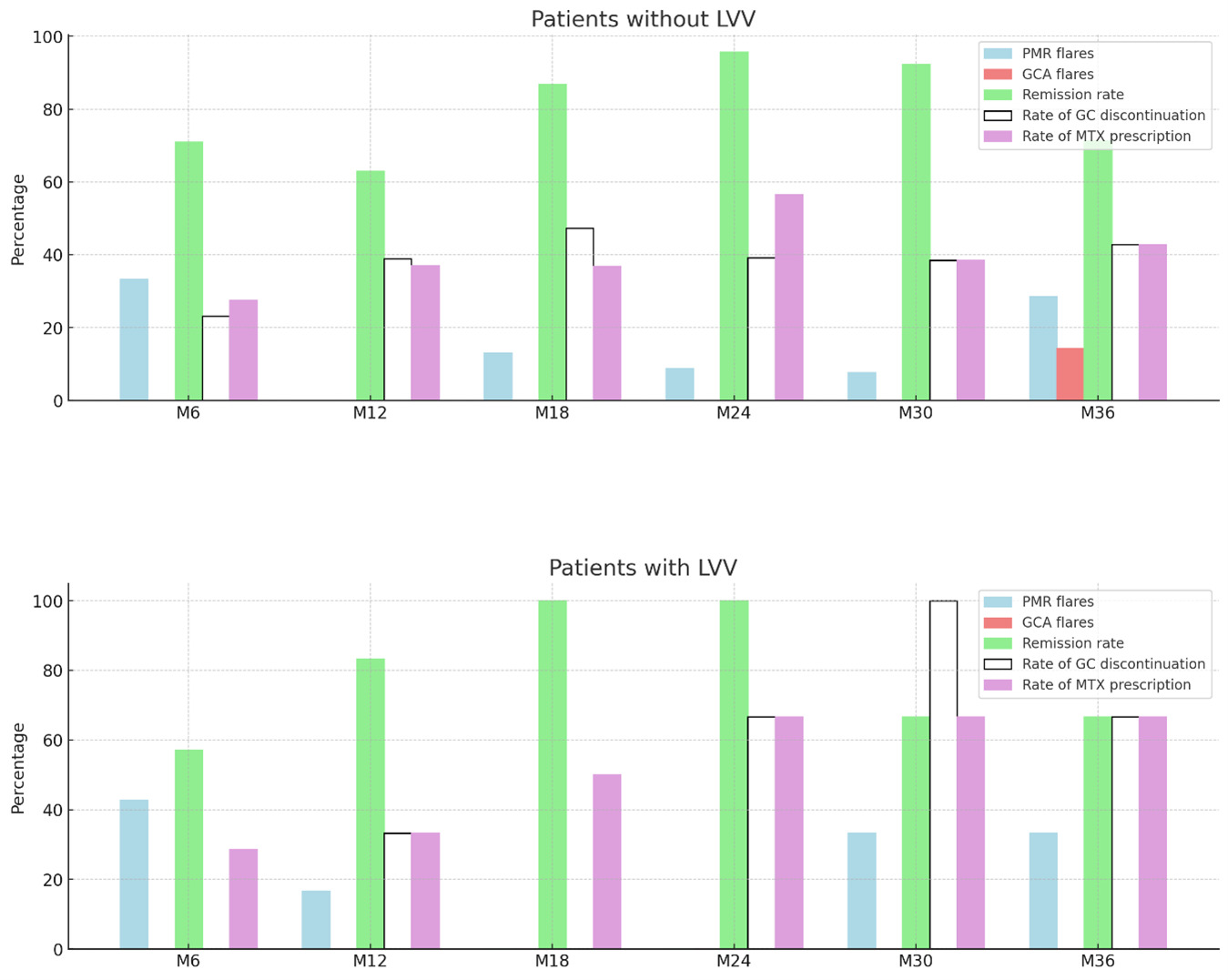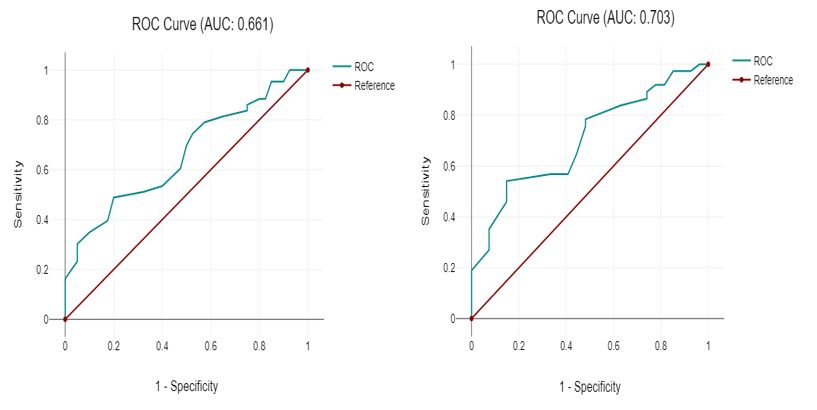Session Information
Date: Saturday, November 16, 2024
Title: Vasculitis – Non-ANCA-Associated & Related Disorders Poster I
Session Type: Poster Session A
Session Time: 10:30AM-12:30PM
Background/Purpose: Polymyalgia rheumatica (PMR) and giant cell arteritis (GCA) are related inflammatory diseases characterized by increased musculoskeletal and vascular uptakes of 18-Fluorodeoxyglucose (18F-FDG) at positron emission tomography/computed tomography (PET/CT). In contrast to GCA, where large vessels’ involvement is associated with increased disease flares and vascular complications, the prognostic significance of nuclear imaging findings in PMR is less known. The aim of our study was to evaluate if increased baseline joint and vascular uptake of FDG could predict the clinical outcomes of patients with PMR followed-up for three years.
Methods: Eighty-three patients diagnosed with PMR according to Bird et al criteria (mean age 72.2 ± 8.4, females 66.2%) were included. None met the ACR 1990 classification criteria for GCA. At first visit (V0), patients underwent clinical, laboratory assessments and FDG-PET/CT; follow-up visits were performed every 6 months for a mean of 3 years. Clinical outcomes included the number of relapses, remission rate, cumulative glucocorticoid (GC) dosage, need for methotrexate (MTX), and death.
A relapse was defined as the reappearance of symptoms of PMR or the onset of GCA manifestations, accompanied by an increase of the inflammatory markers. Remission was ascertained according to two definitions: a PMR disease activity score < 7 [1] and as per Delphi-based consensus [2].
Joint and vascular FDG uptake were visually evaluated in comparison with liver uptake and summed up to obtain the total joint score (TJS) and the total vascular score (TVS).
Results: Grade-2 LVV was present in 32 (39%) out of 83 patients with PMR and grade-3 LVV in 10 (12%). The average prednisone daily dosage prescribed at V0 was 15.4 ± 6.3 mg and 19 patients (23%) were already prednisone-treated. At follow-up, 35% of PMR patients experienced at least one PMR flare and 10% showed at least one relapse in the form of GCA. The highest remission rate (92%) was achieved at the 24th month (Fig 1).
The baseline TJS was inversely associated with PMR relapses (β = -0.22, p = 0.04). In GC-naïve PMR patients, increased TJS values were directly associated with a higher likelihood of achieving remission at 6th month (OR = 1.11, 95%CI [1.01-1.23], p = 0.02). None of these associations were influenced by the initial treatment with GC or MTX at mediation analysis (all p > 0.05). However, the cut-off value of TJS = 19 displayed a sensitivity of only 50% and a specificity of 30% in predicting remission, considering the events over the three years of observation (areas under the ROC curves < 0.8, Fig 2).
Baseline TVS was directly but marginally associated with MTX prescription at follow-up (β = 0.08, p = 0.01) but the presence of grade-2 or 3 LVV at baseline was not significantly associated to poor prognostic outcomes at univariate analyses (all p-values > 0.05).
Conclusion: High FDG-PET/CT-detected musculoskeletal inflammation may be a positive prognostic factor in PMR and might potentially identify phenotypes of PMR patients better responding to GC treatment. Conversely, higher TVS values might predict the need for immunosuppressive treatment.
References: [1] Leeb B et al. Ann Rheum Dis 2004, [2] Dejaco C et al. Ann Rheum Dis 2011
To cite this abstract in AMA style:
Hysa E, Camellino D, Bernini C, Clini P, Bauckneht M, Morbelli s, Sambuceti G, Gotelli E, Sulli A, Cutolo M, Cimmino M. Higher Baseline FDG Musculoskeletal Uptake at PET/CT Is Associated with a Higher Remission Rate in Polymyalgia Rheumatica: A Retrospective 3-year Observational Study [abstract]. Arthritis Rheumatol. 2024; 76 (suppl 9). https://acrabstracts.org/abstract/higher-baseline-fdg-musculoskeletal-uptake-at-pet-ct-is-associated-with-a-higher-remission-rate-in-polymyalgia-rheumatica-a-retrospective-3-year-observational-study/. Accessed .« Back to ACR Convergence 2024
ACR Meeting Abstracts - https://acrabstracts.org/abstract/higher-baseline-fdg-musculoskeletal-uptake-at-pet-ct-is-associated-with-a-higher-remission-rate-in-polymyalgia-rheumatica-a-retrospective-3-year-observational-study/


